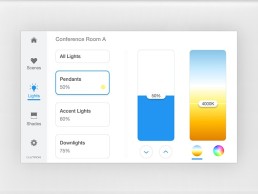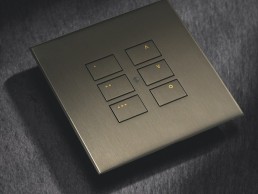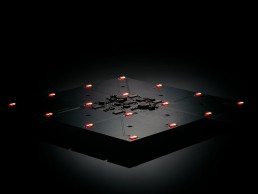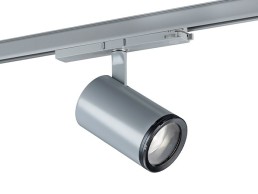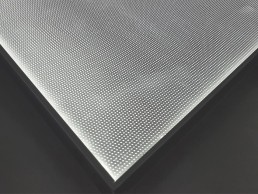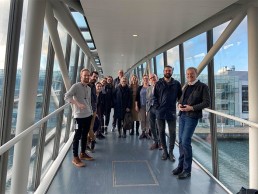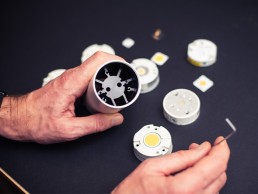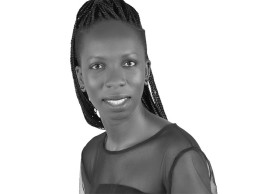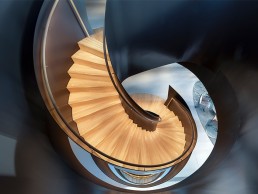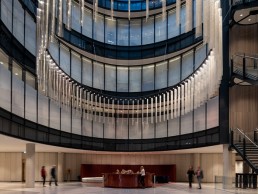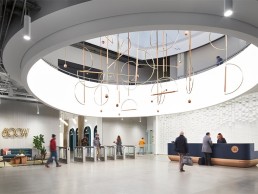Lutron Athena Expansion
Athena, Lutron’s newest architectural lighting and blinds control system, is getting even better. A brand new touchscreen now gives you easy access to customise the environments. Behind the scenes, Athena’s flexible DIN panels make it simple to control any load type under one system. The system further expands with the new DALI emergency-testing feature built right into the Athena app, and offers extended third party integration capabilities.
Valmont Koli Wooden Poles
Decorative Koli wooden poles from Valmont Structures are naturally captivating and sustainably resourced. These square tapered Koli columns bring unique personality to pedestrian and traffic areas through natural beauty and creative application. Valmont harvests the raw materials from sustainably managed, PEFC certified forests and manufactures the shafts from GL28h glued-laminated timber.
Rako EOS Keypads
The EOS range of wired and wireless keypad controllers from Rako blend a classic, timeless design with easy-to-use and customisable control that will appeal strongly to specifiers and their clients. The attractive, screwless design of the EOS keypads create a clean, uncluttered aesthetic, with seven different finishes to suit contemporary or more traditional interiors. Recessed into each plate are six push buttons, offering a reassuring, tactile interface that allows easy configuration to suit client needs with custom engraving also available.
Schnick-Schnack-Systems D Series
With the D series, Schnick-Schnack-Systems is addressing equally demanding lighting designers as well as architects because this video-controlled RGBW series is equipped with high quality and efficient RGB LEDs as well as white LEDs with excellent colour rendering features.
The LED modules of the D series are easy to control with video sources. An internal colour processing takes care of the pixel-perfect conversion from RGB to RGBW.
Hacel Aart
The new Aart range by Hacel combines a contemporary style and minimalistic design with powerful performance and functionality. The elegant power spots feature an adjustable beam and are available in a choice of lumen outputs up to 3,485lm. The Aart is available in Midi and Micro sizes and is ideally suited to retail, art galleries and museum applications. Hacel’s innovative LED luminaires can incorporate the latest Bluetooth Low Energy control platforms, offering intelligent, revolutionary wireless lighting control.
Applelec Green LED Light Sheet
Supplying the design industry with the first, fully environmentally friendly light panel, Applelec Lighting announces the launch of their Green Applelec LED Light Sheet.
Manufactured at the brand’s West Yorkshire premises, Green Applelec LED Light Sheet has been developed to help improve its carbon footprint, whilst still delivering a premium backlighting product. Providing a more sustainable option, Green Applelec LED Light Sheet is the first light panel to utilise recycled and recyclable materials.
In Search for Answers: Light4Health Online Course of Health Research for Interior Lighting Design
Asst. Prof. Dr. Karolina M. Zielinska-Dabkowska IALD, IES, CIE, MSLL, RIBA, presents the work of Light4Health Consortium. She explains how the dialogue that was initiated by this project will continue to share research knowledge and exchange best practices across the lighting community.
Three years ago, when I wrote an article in arc called: Human Centric Lighting - The New X Factor? (arc no. 108 Feb/Mar 2019), my intention was to raise questions in relation to the new topic and to find solid, research-based answers in the years to come. Today, I am happy to report that the lighting community, with the Light4Health Online Course of Health Research for Interior Lighting Design, has a useful tool, and consortium members have managed to close the gap between research and practice/application, and translate complex research into an ‘easy to digest’ format for end users. In
What assured me about the quality of the content, is the fact that scientists such as Dr George Brainard and his Lighting Research Lab team, have joined this project as worldwide experts to advise about the physiological aspects of light and lighting. They also provide guidance on the use of appropriate lighting matrices. This includes tutorials on the use of CIEαα-opic Toolbox. Thanks to this knowledge, I’m hopeful lighting professionals will be confident enough in using circadian protocols. The course content is open access and free to use by either lighting students or practitioners through self-study. This includes the syllabus and materials for Higher Education providers and external designers to use in whole, or in part, within their designs or lecturing.
Course Description and Goals
‘Light4Health’ (L4H) was a three-year Erasmus+ Strategic Partnership Project, which investigated the impact of light on health, wellbeing, and the indoor environments we live in. A novel cross-disciplinary course was developed, intersecting lighting design and health research via the selection of the most relevant health research methods, tools, and findings in Neurology, Photobiology, Neuroendocrinology, Neurobehavioral Studies, and Psychophysiology of Perception, as well as Behavioural, Cognitive and Environmental Psychology. This knowledge was then introduced into lighting design curricula that higher education institutions can adopt. The project involved experts from Neurology, Light and Health Research, Lighting Design, Architecture, and the Built Environment. Underpinned by scientific research, the light4Health project, supports richer understanding about informed lighting designs for domestic, educational, healthcare and other types of premises. The project’s inclusion of work by TJU for NASA, ensures that lighting design and performance will now be optimised for human health and wellbeing.
Course Content
The online course includes five educational modules. It presents different available tools, concepts, and research findings to inform lighting design. This is achieved in two distinct ways: (1) by exposing students to knowledge and examples of lighting-related health research in different fields of psychology and physiology; and (2) by guiding students to learn how to conduct their own evaluation and data collection: by identifying what can be measured, and how measurements are interpreted.
Course Modules
Module 1: Introduction to health-related research for lighting design
Provides participants with a short history about light and health, and why we need to consider health as part of lighting design. The effects of light on the human body are also covered with an introduction to aspects of the physics of light and the physiology of vision.
Module 2: Review on lighting basics and health and wellbeing research topics
Provides a review of lighting basics and lighting-related aspects of health. Included is daylight in architecture, daylight’s impact on health, and, in general, the neuroendocrine, neurobehavioral, and circadian effects of light on the human body. The psychology of light is also introduced; more specifically, how light is used as a visual trigger for psychological and behavioural impact. In addition, the topics of glare and flicker are discussed.
Module 3: Software, measuring devices and evaluation tools
This module investigates software, measuring devices, and evaluation tools. Metrics are presented which can be used to assess the potential for the physiological impact of lighting, and different software and measurement tools are discussed. In addition, some assessment techniques for subjective impressions of a space are presented. Finally, a tour is given of the Jefferson Lighting Research Lab.
Module 4: Standards and best practices
Provides an overview of standards and good practices. Metrics for daylight evaluations are presented, and the “Manchester Recommendations” for healthy daytime, evening, and nighttime indoor light exposure are introduced. Moreover, design integrations are discussed. This involves employing measurements and design criteria for physiological impact and visual perception.
Module 5: Application and examples from research and practice
Provides application examples and case studies from research and practice. In this context, several examples of light and health research are presented. This includes project examples from workspaces, and educational and healthcare environments. Specialty applications (e.g., space travel, users with autism), and concepts of spectral modelling for light and health considerations, double dynamic lighting, biophilia and information on therapeutic lighting applications are also included.
Who is behind the course?
The Light4Health consortium partners consisted of six universities, University of Wolverhampton (UK), Thomas Jefferson University (USA), KTH Royal Institute of Technology in Stockholm (Sweden), Hochschule Wismar, University of Applied Sciences: Technology, Business and Design (Germany), Aalborg University in Copenhagen (Denmark), and ITMO University in Saint Petersburg (Russia).
Each partner was selected according to their contributions to the project topics. All of them have a vast and fruitful experience of higher education transdisciplinary curriculum innovation development with international partners, using digital educational platforms. All participating personnel members have research expertise in fields related to lighting and design, including some EU-funded projects. Four out of six partner organisations have strong Master’s study programmes in Lighting Design. UoW and TJU have no Lighting Design Master’s study programme as yet, however, TJU’s concentration in Lighting Design addresses developments in multidisciplinary approaches for lighting with a hands-on curriculum with students from a range of academic programmes. Spearheaded by Jefferson’s Industrial Design Department, this Lighting Design Education curriculum applies cross-discipline education to Lighting Design across 10 departments, including Industrial Design, Architecture, Interior Design, Engineering, Animation, and Medicine.
The following individuals were involved in the preparation of the course contents that were created and piloted during the summer schools:
Thomas Jefferson University
• Lyn Godley, Professor
• George C. Brainard, PhD, Professor
• John P. Hanifin, PhD, Assistant Professor
• Ben Warfield, Operations Support Specialist
KTH Royal Institute of Technology
• Ute C. Besenecker, PhD, Associate Professor
• Foteini Kyriakidou, Lecturer
• Iris Molendijk, Research Engineer,
• Federico Favero, PhD Candidate, Lecturer
Hochschule Wismar
• Karolina M. Zielińska-Dąbkowska, PhD, Assistant Professor
• Michael F. Rohde, Professor
• Bipin Rao, Research Associate
Aalborg University (AAU)
• Georgios Triantafyllidis, Associate Professor
• Ellen K. Hansen, Associate Professor
• George Palamas, Assistant Professor
• Emmanouil Xylakis, Research Assistant
University of Wolverhampton
• Ezekiel Chinyio, Senior Lecturer
• Paul Hampton, Head of Department
ITMO University
• Natalia Bystriantseva, Associate Professor
• Dmitrii Ingi, Research Assistant
• Valeriia Lukinskaya, Research Assistant
There are also 10 associated partners who supported the project with various expertise, equipment, and feedback: VIA-Verlag company/DE, (until January 2020), Università Iuav di Venezia/IT, Vicenza Institute of Architecture/IT, Roma Tre University/IT, Tallinn University/EE, Janowicz Architekci/PL, eldoLED/NL, Seoul Semiconductor/EU, QLAB Laboratory of Light/PL, Solemma/US, GL Optic/PL.
This course has been extensively reviewed by design practitioners e.g. architects and lighting designers, academics in the fields of lighting and health research, and students. The course was launched in August 2021 and it received a very positive response. As the online course becomes embedded in higher education curricula, it will continue to inform designers and young practitioners to develop innovative ideas to improve building performance and improve environments that support light for health.
Several of the partner universities are already using Light4Health resources in their teaching, and indications are that it will be more widely incorporated (e.g. 73% of academic reviews indicated they are likely/highly likely to incorporate the materials in their teaching). Architects, lighting manufacturers, and lighting practitioners that attended launch and dissemination events, or reviewed the materials, expressed a strong interest in using the materials to inform their activities.
The L4H consortium partners acknowledge that the content, while extensive, does not encompass the full extent of the work undertaken in health-related lighting design research. The current course content is subject to refinements, updates, and additions in the future. Comments and suggestions are still welcome.
The course is accessible from a Moodle learning management system online at https://course.light4health.net
GreenLight Alliance: The Next Step
Bob Bohannon and Kristina Allison give us an insight into the newly published CIBSE SLL Technical Memorandum, TM66, which offers advice and guidance on how to create a circular economy in the lighting industry.
The life expectancy of some commercial buildings is just 30-40 years. Whisper it quietly, but Bob is not a huge fan of some Victorian architecture, but driving past Hampton Water Pumping station the other day, he realised that this glorious building appears to have beautifully performed its function for some 150 years. Alarmingly, building and demolishing a series of 40-year buildings, rather than a single 150 year one, often yields a higher GDP figure. We don’t measure the environmental impact.
We have to make better use of the resources embodied in our lighting equipment, an unthinking linear economy of Take (resources from the environment), Make (products in factories), Waste (dispose of products into the natural environment) is increasingly no longer acceptable. Product durability and adopting the Circular Economy is the part of the solution to maximising resource usage, keeping (in our case) lighting assets at their highest value, i.e., as an effective luminaire for as long as possible.
A team of us got together and we started listening, consulting, learning, engaging and what is soon to come out of that process is a document and a suite of three tools. The objective being to give information to all, not to tell people they are doing it wrong, but to show how they can do it better. We wanted to enable supply push by creating a nuts-and-bolts tool for manufacturers and to stimulate demand pull by giving specifiers and clients the questions they need to ask.
The document is CIBSE SLL Technical Memorandum TM66 on Creating a Circular Economy in the Lighting industry, to be published October 2021. It describes the background to the Circular Economy in general, including the drivers behind its adoption, but most importantly it gives guidance on how the circular economy affects each sector of the industry, what opportunities it may bring them and what to do next.
At the same time comes the publication of SLL’s Circular Economy Assessment Method for Manufacturing (CEAM-Make) which allows manufacturers (or specifiers if they so wish) to assess the performance of their luminaire and its supporting ecosystem in terms of its Circular Economy performance. The tool accepts the complexity that sustainability questions bring, but converts that to a simple, easy to understand star rating. The objective is to move as many products and manufacturers from zero to hero (4) as quickly as possible by giving them the detailed issues to consider. The assessment method is weighted to cover differing products, comprehensive and covers product design, manufacturing, materials and supporting ecosystem.
The CEAM-Make may be a little too in depth for a busy specifier to use every time they need to choose between luminaires, or in the transition period where manufacturers have not yet fully completed their CEAM-Make assessments. Therefore, we created CEAM-Design, being a specifier support tool. You could almost think of it as a triage tool, being essentially the most important questions to ask a manufacturer.
All the tools in the suite have been created in full consultation with people knowledgeable in the field, from manufacturers to product designers, lighting designers and end users. The tools will be updated, but the hope is that they will deliver the practical know-how, understanding, and a level playing field for claims that make an already green industry in terms of its product’s in-use energy performance, truly sustainable.
Roger Sexton, Stoane Lighting
For Stoane Lighting, TM66 couldn’t have been more welcome.
We needed a metric on the Circular Economy to be certain there weren’t holes in our approach and to market our luminaire designs mapped on a neutral foundation. We had carried out embodied carbon analyses on certain luminaires with CIBSE’s TM65 and, at a whole company level, had accreditations from B Lab and EcoVadis. It’s the specific Circular Economy assessment on our products that we lacked.
Honoured to test drive TM66, we put part of our ZTA range through the CEAM process. It took considerable time to compile our ‘book of evidence’ for the four blocks of questions. Skimming from the 66 number of questions, below we just highlight one per section to give a flavour of the topics covered.
Design
Repairability and upgradeability are focused on. ZTA design permits easy access to (no glue) and replacement of light sources, optics and drivers with common tools and without damaging the luminaire (as also called for in Article 4 of Eco Design Regulation 2019/2020). The ZTA range has extra fixing holes to facilitate subsequent use of different component types due to discontinuation of originals, to harness improved technologies (e.g., LED modules becoming more efficient, or gear losses decrease) or to cater for a changed need at the installation. For the same reason there is also some leeway mechanically and thermally.
Manufacturing
Localisation sliders, e.g. ‘Geographical Distance from Final Assembly to Site’ needed some thought. For our submission we assumed Edinburgh to London, but we think this question leads the way to a ‘CEAM Project’. We scored well with the ‘Average Supply Chain Partner geographical distance from final assembly location’ question. With Stoane Lighting, all of our parts are designed and made in-house or we use local specialist machinists, paint shops and anodisers, etc. Only the optic, driver and LED module come from overseas.
Materials
Recycling is questioned here. The main material used in the ZTA luminaire is aluminium, which is infinitely recyclable. The aluminium we buy (from Derbyshire) has a recycled content of 65-85%. Recycling components comes down to modular design. If components are common across the ranges, or even indeed across multiple ranges, then the likelihood of being able to reuse components increases.
Ecosystem
The norm for remanufacturing involves a factory return – but what if this isn’t possible? Say a building is in constant usage. This section therefore questions related services that are available. Stoane Lighting can drive a mobile workshop to installation to carry out repairs or upgrades.
We appreciated the thoroughness of the TM66 review and scored well. But we can see where we must make improvements – we did not score high marks everywhere. We do not use, other than for making prototype parts, 3D printing (we are not convinced yet by 3D printing of aluminium but watching progress in that industry). In terms of recycling our own waste we are making our very first steps with melting down machine room offcuts and using gravity die casting to make 100% recycled aluminium pendants.
I will be interested to see how generally the industry and standardisation bodies evolve in the context of the Circular Economy. The market reaction to our uptake of TM66 has been positive. We are being asked for TM66 assessments of our luminaires before the guide’s publication. One such request came from Buro Happold who want to use our Tadpole luminaires for an installation connected with COP26 this year in Glasgow which will be covered in a future article in this series.
www.greenlight-alliance.com
www.sll.org.uk
www.thelia.org.uk
www.stoanelighting.com
To LED or not to LED: The Global Opportunity to Remove Toxic Mercury from Lighting
The Clean Lighting Coalition explains the issues surrounding the disposal of toxic mercury from old lighting fixtures, and what we can do to help.
"Good for public health, the environment, energy saving, carbon saving and the climate crisis… so why is there any resistance?”
Most professionals in the lighting design community reading this are likely already only specifying LED lamps in their designs, without context for global issues surrounding the continued use of so-called legacy technologies. As developed and industrialised markets increase efforts and regulations to limit the manufacture, sale, distribution and installation of mercury-containing fluorescent lamps, under-regulated markets must not become dumping grounds for outdated, environmentally damaging lighting products. In emerging economies, fluorescent lamps are still one of the market leaders, often having a greater market share than the more efficient LEDs. Professionals influence policy makers; this article is a global call to action to stop environmental dumping of legacy, toxic technologies in emerging markets.
Until a decade ago, fluorescent lights were viewed as the energy-efficient alternative to less-efficient incandescent and halogen lights. Fluorescent lighting however contains mercury, a known neurotoxin that is extremely hazardous to people and the environment. Mercury is on the World Health Organisation’s top 10 most dangerous chemicals to public health. Mercury exposure can affect the nervous, digestive and immune systems, as well as the lungs, kidney, skin and eyes. While the risks associated with mercury in fluorescents were tolerated as a necessary trade-off for the efficiency benefits, this is no longer necessary given the widespread availability of LED alternatives.
Typically, less than 10% of mercury [in fluorescents] is recovered. A 2016 report by the Danish Environment Protection Agency found that Denmark had achieved an overall lamp collection rate of only 36%. Note that Denmark has one of the highest collection rates in the EU. In the United States, recycling rates have been reported at 29% for industry recycled fluorescent lamps and CFLs, and at only 2% for consumers. The case is similar in other wealthy countries that have systems in place for electrical and electronic waste management; recycling is still limited as the small size and weight of lamps makes them easier for consumers to dispose of in general waste. When it comes to emerging markets, there is hardly any infrastructure to deal with any mercury hazardous waste and most of it ends up in the environment.
Availability of Mercury-Free Direct Retrofits
Today, thanks to major advances in LED technology, there are mercury-free LED replacement lamps available to replace all types of fluorescent lamps – different sizes, lengths, ballast types (i.e., magnetic/starter and high frequency electronic), colour temperatures, and regular, high output and ultra-high light output levels. Lamps are also available that are “universal” and can operate on a variety of ballasts and input power configurations. This approach to the design and marketing of the products removes barriers to upgrading to mercury-free LED lamps by enabling the end-users to continue to use the same luminaires, and simply change the lamp.
A Global Ban on Toxic Lighting
This year, global lighting markets have a unique opportunity to say farewell to outdated, inefficient fluorescent technologies and accelerate the transition to an LED future. LED companies and stakeholders can support this transition by endorsing a global campaign to remove exemptions for mercury in lighting under the Minamata Convention on Mercury.
In May 2021, the 36 parties (countries) representing the African region to the Minamata Convention on Mercury, proposed an Amendment to eliminate special exemptions for mercury in general illumination lighting products. The Convention, named after the city of Minamata, Japan, which experienced widespread mercury poisoning after wastewater from a nearby chemical plant was discharged into the sea, was launched in 2013 with the goal to “Make Mercury History” by eliminating the use of mercury in products and processes worldwide. The Convention, now made up of 134 parties, entered into force in 2017 and has been successful in the phase out, phase down and regulation of the use of mercury in a number of products and processes e.g. dental amalgams, mercury mines, and control of emissions to the environment.
Despite this progress, the Convention includes special exemptions for mercury-based fluorescent lighting products, citing insufficient cost-effective alternatives across global markets. However, the rapid development and increasing accessibility and affordability of mercury-free LED lighting makes the exemption unnecessary.
An Equitable Transition to Clean Lighting
In Europe, policymakers have been actively working to remove inefficient, toxic mercury-containing fluorescent lighting from the market. On 1 September, 2021, the revised lighting regulations under the EU Ecodesign Directive went into force banning retrofit CFL.i and T12 fluorescent lamps. The EU also recently published draft revisions to the regulations on hazardous substances that will ban the sale of virtually all fluorescent lamps in the EU in 12-18 months. However, in contrast to their ambitions at home, the EU also proposed an amendment to the Minamata Convention that would continue to allow the sale and export of banned mercury-containing fluorescent lamps to other parts of the world.
As wealthy countries and developed economies like North America and Europe lead the transition to LEDs, the rest of the world must not be treated as a dumping ground for outdated, mercury-laden fluorescents. In unregulated markets, particularly in emerging economies, fluorescent lamps are still market leaders. Without intervention, a global transition to clean super-efficient LED lighting may take years due to lobbying efforts of fluorescent lamp suppliers.
The Clean Lighting Coalition Leads the Global Lighting Transition
The Clean Lighting Coalition (CLiC) is an independent campaign aiming to leverage expert knowledge and clean lighting stakeholders to transition global markets to safe, cost-effective, and energy-saving LED lighting by removing the exemption for fluorescents in the Minamata Convention. The Coalition brings together LED companies, associations and stakeholders to prove market readiness for this global transition. If the African Lighting Amendment (ALA) is adopted at the upcoming Convention of Parties (COP4), it would lead to a global phase out of toxic, mercury-laden fluorescents by 2025.
LED Companies Signal Environmental Responsibility & Commitment to Equity
By joining CLiC and supporting the phase-out of fluorescents, LED companies can affirm their commitment to environmental protection. Recent national disasters ravaging the globe – heat waves, hurricanes, storms, wildfires, are showing that action on mitigating carbon is not misplaced. In the lead up to the upcoming 2021 Climate Change Conference (COP26), the latest Energy Transitions report recommends six actions that, if agreed upon and implemented during the 2020s, will make it possible to deliver the Paris agreement and limit global warming to 1.5C. Action #6 is reinvigorating energy and resource efficiency. Eliminating exemptions for fluorescents under the Minamata Convention will remove 232 tonnes of mercury pollution from the environment, both from the lamps themselves and from avoiding burning of coal in power plants. It will also save 3.5 gigatonnes of CO2 emissions from power plants (cumulatively between 2025-2050).
Supporting the ALA is a low-hanging fruit on climate action, a sentiment well echoed by lighting designers Perkins&Will: “To reduce carbon at the earliest stage of the design has the potential for the largest reduction of carbon.”
www.cleanlightingcoalition.org
To support the global transition to clean, energy-efficient LED lighting, sign the CLiC Industry Pledge or reach out to the CLiC Industry Engagement Lead Nyamolo Abagi at nabagi@cleanlightingcoalition.org.
Freshfields Bruckhaus Deringer, UK
Lighting designers at 18 Degrees created a unified, seamless lighting scheme for leading legal firm Freshfield Bruckhaus Deringer’s new Bishopsgate headquarters.
Freshfields Bruckhaus Deringer (Freshfields), is one of the world’s leading legal practices and a member of the prestigious ‘Magic Circle’ of London-based solicitors. The company has recently relocated its headquarters, moving from Fleet Street to a new development at 100 Bishopsgate in the City of London.
Lighting designers at 18 Degrees worked closely with interior architects ID:SR to develop the lighting strategy for both the front and back of house areas of the new workspace, spanning 15 storeys.
Paul Beale, Co-Founder of 18 Degrees told arc about the collaborative nature of the project. “ID:SR are not restrictive in their work. They don’t say ‘we want you to use this light in this place’, instead they told us what they were trying to achieve with the space – the look, the feel, the type of people using the space – and asked us to instruct them on what was needed. When your collaborators think that way, it always leads to the best outcomes.”
The collaborative approach in the design led to a lighting system that sits in harmony with the wider interior design, forming a part of a visual journey that takes visitors from the reception spaces through to the client-facing areas, the practice floors and back of house areas.
Beale continued: “The spaces had to make sense visually, when you go from the reception, right through the journey of the building. Lighting had to support and reinforce that concept.”
While light was used as a wayfinding, navigational tool within the building, 18 Degrees also aimed to create a comfortable environment for the office workers. Maria Favoino, lighting designer at 18 Degrees, explained: “We wanted to make sure that they were happy with the light levels, because some of the client staff still work with paper documents and spend a lot of time reading. Within the mock-up stages, we took inspiration from volumes of light. We studied the different layers of light, and established that it couldn’t just be downlighting; we had to do something more that would give us diffuse light, and different options for people.
“There were daylighting studies looking at how we could implement different layers of light – not just with a table lamp, for instance, but maybe with an uplit element too. The central part was defining the user of the space, and at the same time creating this wayfinding element to help them to the coffee point or the break areas, for example. It was also important that these spaces have a different level of light, to give the user the feeling of being in a different space, taking a break from work.”
“That sort of fluidity in terms of how a space can be adapted to different uses throughout the day, that’s why those layers of light are built in,” Beale added. “It might be an uplight, or light directed at the wall, or table lamps, as well as the standard lamps that come from above.
“It’s a lighting scheme designed for people. We didn’t look at it with the approach of getting 300-500lx on the desks. No one talked about lux levels. The conversations were all about how it has to feel, who is going to be using the space, how they arrive at the building and what that journey is.”
Taking a special focus on the people using the space also led to a number of challenges for the lighting designers, because of the wide scope of people working for Freshfields. Beale continued: “We’re catering to everyone from fresh-faced graduates who might be 21-22, through to some of the partners who may be in their mid to late 70s. As our eyes degrade and our eyesight deteriorates with age, how do you light a space that caters for a 78 year old that isn’t going to be too bright for the 22 year old?
“We had to cater to a really wide range of demographics within the same space. That led to sophisticated controls, and then the challenge was how we do sophisticated controls without a massive, complicated control panel. We had to keep it simple.”
To do so, 18 Degrees managed the various layers of light through the lighting control system. This included the introduction of elements such as presence detectors and daylight sensors linking to the window blinds, which in turn resulted in a more simplified control system for the end users. “A lot of elements don’t need to engage with an interface if you’ve got an inherently tunable system,” Beale continued. “And then the fine grain control can come from the users. If it’s arranged in such a way then the interface with the user can be something really simple, and that’s what we’ve got here.”
While the increased controllability aids staff wellbeing, the project has also been carefully planned to minimise its environmental impact too. Freshfield’s tenancy is powered from 100% renewable energy, and the LED system and associated controls helped the project to achieve a BREEAM Excellent sustainability rating. The new fitout has also resulted in a 30% energy saving compared to Freshfield’s previous location.
And Beale believes that the decision to use top quality fixtures helped in achieving this status. “We’ve got really good quality lights in there. The light within the space has a very high colour rendering, etc. You walk into the space and one of the first things that you notice is that the colours are really vibrant. Because of that we didn’t need to put too much light into the space to make it feel well lit.
“Sometimes, projects that have an environmental agenda can tend to feel gloomy, or like they’re trying a little bit too hard, and as a result you don’t end up with a very nice space. Here, you walk into the space and think “wow, this is a really nicely lit environment”.”
The high quality architectural fixtures throughout are offset by a range of beautiful decorative pieces, from large pendants in meeting rooms to striking chandeliers in the reception spaces. This again was built on a strong collaborative relationship between 18 Degrees and ID:SR.
“It was a real collaboration between the interior designers and ourselves. Fortunately, they have a superb design sensibility.” said Beale. “We’ve got a custom Roll & Hill pendant in one of the meeting rooms, which is more of a sculpture. It’s just incredible. We’ve got a few really beautiful signature pieces like that throughout.”
Favoino added: “We always collaborated and selected items based on what the space would be used for, what team would be working there, etc. The interior designers were always open to our suggestions. They were also really careful about the materials as well. There were metallic finishes in some areas, while in others it was softer. It was always in balance with what was surrounding it – the carpet on the floor, etc.”
To allow the decorative flourishes to take centre stage, 18 Degrees opted for more hidden, recessed architectural fixtures – a combination of spotlights, downlights and linear track fittings provide the ambient lighting throughout.
“We hid so many lights, for instance in the meeting rooms there is a blackout blind and then a sheer hanging down. There are concealed lights behind the sheer curtain tracks; all you see is a wonderful glow to the drapes. You can’t see the light fittings, but you get this beautiful effect. This was just one of the layers that we introduced into the scene within that room to give the client the flexibility to use it for a whole range of different functions.”
The use of hidden lighting elements is also on show at the striking central staircase. A huge, spiral structure connecting the client-facing floors, the staircase is one of the highlights within the workspace, but rather than shine a spotlight on it, 18 Degrees opted for a more subtle approach, illuminating it with recessed handrail lighting, courtesy of The Light Lab.
“The staircase was a key part of the project, and a combined effort from all parties,” Favoino continued. “The architect wanted to create this sculptural element between the client floors. We thought about how we could highlight this in a soft way, and decided to just use handrail lighting.”
Beale added: “It’s one of the main focal points of the space. I don’t think there is any one singular focal point, instead there are a whole series of moments, but that’s certainly one of the highlights.”
While many projects of this type may employ the services of a lighting designer for the front of house, client-facing areas, a more integrated approach was taken for Freshfields, with 18 Degrees delivering lighting in all spaces. This enabled a seamless visual transition between the spaces, acknowledging that the staff are the company’s most valuable asset and linking their work environment with their wellbeing.
Beale explained how the lighting provides a sense of connection throughout the building: “There is a consistency in terms of colour temperature and quality of light, colour rendering, etc, but within that, there’s scope for varying the intensity of light to suit the operation and the mood of the space, whether it’s a reception space, a dining room, a room for video conferencing, or circulation on the stairs.
“Each of those spaces can have its own personality and some might be lit from overhead, some might be lit more with lamps, and then spaces for video conferencing become a bit more technical with a higher degree of control. But there is a consistency with the colour temperature and quality of fittings.”
The level of consistency that a more integrated approach brings to the project is something that Beale believes makes it stand out as a piece of architectural lighting design, not least because it allowed his team to truly make a difference, whereas in other, less coherent projects, that may not have been possible.
“One of the best things about this project has been that we were able to design the lighting not just for the front of house, but to the wider space,” he concluded.
“The reason that we get out of bed in the morning is to try and make a difference through our work. You can only make a marginal difference if you’re lighting a space that someone is going to walk through for 25 seconds to then sit at a desk where they don’t see that light again until they go home.
“We had the privilege of lighting spaces that people are going to experience day in and day out throughout their careers, ranging from the very young to the very old. That is so rare as a specialist lighting consultant, and that was the highlight of the project, for me, being able to make a difference across such a vast scope.”
100 Liverpool Street, UK
Speirs Major has created a striking lighting scheme for the 100 Liverpool Street retail and office redevelopment in London, characterised by one of the UK’s largest bespoke chandeliers, The Cloud.
Achieving a BREEAM Outstanding rating, the 100 Liverpool Street large-scale flexible retail and office redevelopment is the latest stunning project to join the esteemed profile of lighting design for Speirs Major.
Located adjacent to Liverpool Street Station and its future Crossrail Station in London, 100 Liverpool Street underwent an extensive strip-out, rebuild and extension to provide a sustainably-constructed, 48,300sqm, lettable office space.
Speirs Major worked closely with Hopkins Architects and interior designers Universal Design Studio (UDS) to conceive the lighting scheme for the vast space, including, arguably, the UK’s largest chandelier constructed to date, dubbed The Cloud.
The UK-based lighting designers developed the lighting schemes for external after-dark identity, ground floor and mezzanine retail arcades, office entrance lobbies, roof terraces, the second-floor lobby and atrium, as well as shared amenities such as the atrium stair, bike store, changing rooms and WCs.
arc caught up with Senior Partner of Speirs Major, Mark Major, to discuss the lighting journey for the expansive building. “We were initially approached by British Land to bid for the project. 100 Liverpool Street was the first project in Broadgate that we worked on, but since then we have prepared a full site-wide strategy and we are working on several other projects, including 1 Broadgate with AHMM, and Exchange Square with DSDHA,” he said of winning the project opportunity.
“We were given an outline brief through a schedule of areas and scope, but the specifics of the lighting brief were developed collaboratively between ourselves, British Land, Hopkins Architects and UDS, allowing for a more flexible and creative approach.”
The ground floor Octagon Mall retail arcade also serves as an important east-west circulatory route, linking the station, Liverpool Street, Bishopsgate, and Broadgate Circle. Enhanced by the soft reflections of shoppers and the sinuous geometry of the lighting channels, the ceiling design encourages a gentle flow of movement. This is achieved by crafting a balance of brightness, which manages any contrast when moving between inside and outside, while also ensuring the retail frontages have prominence.
Major explained: “The project can be viewed as two distinct parts – the retail arcade connecting to the wider public realm, and the office development. For the retail space, the lighting narrative concerns creating a sense of flow – supporting intuitive wayfinding between Liverpool Street Station, Broadgate Circle and 1 Broadgate (in the future), while amplifying the presence of the retail offer within the arcade. The office project also has an element of flow – we considered what the journeys that people make through the buildings should feel like and, in line with the architectural and interior design approach, we focused on creating great atmosphere in the ‘public’ spaces that would support a buzzing, social, collaborative environment.
“The lighting supports the experience of these journeys, which can vary depending on the mode of arrival (e.g., by train, tube, foot, bicycle) and the mood and motivation of the individual – busy and focused or meandering, browsing, socialising, etc. We designed the lighting to describe and enhance these journeys, visually defining and connecting spaces and areas, and building in moments of dwell. We have a lot of experience with this type of lighting – airports, public realm spaces, galleries – as with this project, for all these the lighting of circulation is hugely important and often underrated.”
Two entrance lobbies, to the south and north, provide access to the office space. In each a wash of light onto key vertical surfaces supports a strong external identity while promoting legibility and wayfinding. Highlights to artwork, furniture, and planting contribute a warm ambience, while the distinctive pendants chosen in collaboration with UDS provide a sense of human scale and essential task lighting. Lighting is also integrated into the handrails of the escalators, which avoids problematic maintenance and provides additional visual cues that aid in wayfinding.
Upstairs, the second-floor lobby and atrium hold the main reception, café, informal meeting, and flexible working areas. Again, highlights are added to selected vertical surfaces, reinforcing the clear legibility and wayfinding. Appropriate ambiences are achieved with further task and feature lighting pieces in zoned areas, such as the reception desk, seating areas and workstations.
“Architecturally speaking, we considered how we would address each space, defining zones, and revealing materials, textures, and colours. For the second-floor lobby, light to the perimeter helps define the boundaries, making the spaces more legible and creating a sense of depth,” said Major. “The atrium required special consideration, with its bold conical shape, vast size, dramatic exposed staircase, and the multiple viewpoints from the offices. Having had the experience of hanging lighting objects within large voids in a number of projects over the years, we knew that this could bring several benefits. By creating a point of reference, hanging an object in such a space can both provide a sense of human scale, while also emphasising the grandness/volume. From a practical point of view, it also puts the light where you need it.”
The hanging object referenced here by Major is thought to be the largest chandelier ever constructed in the UK, known as The Cloud.
“We started by sketching some ideas, and as a design team settled on having just one large object, rather than a series of objects – a clean, simple, and practical solution that could be executed at the right scale. In fact, the geometry of the piece is entirely derived from the architecture, considering elements such as the cladding grid,” explained Major.
“We also needed to consider practical issues such as the impact of the hanging points on the cleaning cradles. So, in terms of form, size and disposition, the form evolved to perfectly occupy the exact space it needed to. We conceived of the design as a simple ring from which we would hang blades that reflect and soften the light from a series of downlights, the latter providing the functional and ambient light to the atrium below. The blades draw on the language of materials that Hopkins and UDS used in the architectural cladding and interior design – light coloured perforated metal with softly curved edges – ensuring that the chandelier also visually belongs to the building.
“There is a similar language in the materials used for the illuminated ceiling in the café bar, which also features tuneable white light, helping to tie the spaces together and enhancing the sense of design cohesion. The design was modelled extensively in 3D and mock-ups, testing various designs of blades to create the soft, light, cloud-like effect we wanted.”
“Because of the dual nature of the blade (one side matte, one side reflective) the effect reads slightly differently depending on which way round you walk – a nod to the natural variation of a cloud. And, if you look closely, the perforations in the blades create an interference pattern that scatters light and creates further ‘cloud-like’ textures – so essentially more clouds within the cloud. Bringing this hugely ambitious idea to reality required a huge amount of work and collaboration within the design team and with the manufacturing partner, Stoane Lighting, and a corresponding amount of bravery from the client. But it has become a very important part of the signature of the building, and it truly brings something very special to the space.”
Continuing higher into the building, the top five floors include setback offices, which open out onto a series of outdoor planted terraces and amenity spaces. Soft lighting within the planting and under the soffit accentuates the textures and helps to soften the indoor/outdoor transitions, supporting safe and easy circulation. The low-level exterior light also supports views out through the glazing from the office interiors and spectacular views from the terraces out across the city, with minimal lighting pollution.
Despite not being directly involved in the lighting for the office spaces here, Major spoke of an evolution her perceives in the lighting of workplaces generally. He said: “Trends that had already begun to emerge, such as increased focus on employee wellbeing and staff retention have been accelerated by the Covid-19 pandemic. Having worked at home for many months, people are keen to retain some of the advantages of increased flexibility (i.e., not being tied to a desk). Interestingly, it seems to be the social aspect of work that is drawing people back, so more fluidity in layouts, more breakout and social spaces, access to natural light, and biophilic design approaches are coming to the fore. For all these aspects, lighting has a huge role to play – supporting the design of workplaces that people will want to return to. In this sense, the design for the communal spaces for 100 Liverpool Street has proved incredibly forward thinking in its design.”
Overall, the project was such a success for all those involved due to the close working relationships between all parties. Major concluded: “It was certainly an ambitious project but highly rewarding. Just the chandelier design and the feature lighting for the bar/café area would be considered ambitious in their own right, but the attention to detail stretches much further right across the whole project, from details like the swept up the plaster cones for the downlights that soften their effect across the ceiling to the clean integration of the linear channel lighting that grazes the walls at the perimeter – each aspect had its own design challenges.
“What made this project so satisfying though, was the level of collaboration between the members of the team, and the engagement and support of the client. That gave us the confidence throughout the project that our ideas would be listened to, and once agreed, we would get the support to see them properly delivered.
“We see it as one of the great workplace projects we have completed, both in terms of ambition and execution.”
600 West Chicago, USA
Lighting designers at Schuler Shook played an integral role in the redevelopment of Sterling Bay’s 600 West Chicago office building, creating a bright and lively space for its tech clients to meet and interact.
Twenty years ago, Chicago’s historic Montgomery Ward catalogue building was redeveloped into a tech destination known as 600 West Chicago. Now, under Sterling Bay ownership, the property has received the WELL Health-Safety Rating and has been transformed again to meet the unique needs of today’s workforce. 600 West Chicago features an expanded retail experience to serve both tenants and surrounding neighbours, modernised tenant amenities, updated interiors, and a renewed focus on accessing the outdoors.
The team at lighting design studio Schuler Shook played a pivotal role in the building’s most recent transformation, brought onboard by the project’s architect Lamar Johnson Collaborative (LJC). Asked to review the lighting design and validate the ideas developed up to that point, Schuler Shook soon found that the lighting design was going to become a more significant component for the project.
“When we joined the design team, they had finished the schematic design phase and were preparing to provide an update to the client for the design development phase,” said Laura Román, Senior Lighting Designer at Schuler Shook. “At this point, we were able to review their progress, conduct lighting calculations for the concepts suggested and provide new lighting design ideas. We also participated in the client presentation to obtain the owner’s approval of the design.
“The interior designers – Charlie Green Studio – came to the table with specific concepts in many areas, which we then confirmed and developed. The overriding narrative was to provide a bright space, with visual clarity and visually stimulating lighting with attractive decorative features.”
One of the main challenges of this project was to transform the lobby and adjacent spaces of the warehouse into bright, invigorating, and comfortable areas that felt open and easy to navigate. This approach was required to facilitate the flow of almost 7,000 people a day that pass through the 21,380sqft lobby to work in the multiple technology companies such as Groupon, Uptake, Tempus, and Big10 Network, that are housed in the building.
The huge oculus in the lobby at 600 West Chicago is a key focus of the space and an area that Schuler Schook was heavily involved with.
The design team wanted to highlight a sculptural mobile that features in the space, with fixtures located at the perimeter of the oculus opening. However, according to Román the team was struggling with fixture placement, considering it produced glare from the various viewing angles. “One idea discussed was to graze the vertical fade of the oculus. This approach was discarded as it would have required introducing a cove at the bottom of the oculus to conceal the fixture.
“While reviewing the renderings, an inspiration came to mind, ‘what about making the vertical face of the oculus the lighting element in itself?’ We discussed the benefits of using a back-lit tensile fabric as a means of providing a soft glow to accentuate the sculptural mobile without hot spots or any glare concerns. The whole team was excited about exploring this solution.
“The next step was to conduct several mock-ups. This is where the idea came to fruition successfully, making it one of the most visually captivating features of the space,” continued Román. “The luminous membrane also contributed to the acoustic absorption of the space, which was an added benefit.”
In terms of lighting levels achieved by the illuminated oculus, a 40-fc average was provided using a low output LED matrix concealed six inches behind the membrane. The LED system was dimmed throughout the day to match the daylight levels penetrating the space via the skylight above and adjacent lobby windows. The colour temperature of choice for the oculus LED system was static 3500K, as tuneable white was cost-prohibitive.
In terms of key architectural lighting considerations on this project, there were several concerns the designers had to keep in mind throughout. The existing lobby had very dark finishes and several hard surfaces that created acoustical concerns. In addition, several partitions in the space made circulation in the lobby cumbersome, blocking daylight contributions from adjacent windows and the skylight above the oculus.
“Considering this and the amount of people that traverse the space in the morning and afternoon during rush hours, the new architectural design ‘opened up’ the space visually and functionally – allowing more daylight into the space,” continued Román. “In addition, existing security checkpoints that blocked the flow of people were relocated to the perimeter of the lobby, eliminating the bottle-neck issues associated with the previous scheme.
“Another major contributor to the visual clarity of the lobby was providing lighter value finishes for horizontal and vertical surfaces. The lighter finishes, coupled with general broad lighting delivered by cylindrical fixtures with uplight and downlight distributions, created the sense of spaciousness that the client desired. To further contribute to this solution, grazing with light all the textured vertical surfaces added visual interest. Other methods of lighting, such as highlighting door frames indirectly and lighting coves, created the perfect visual canvas that demonstrates the success of this lighting design.
“Fixtures were dimmed throughout the day to conserve energy and balance electric lighting with daylight.”
Throughout 600 West Chicago, the entire design team worked hard to acknowledge the building’s history, while also creating something that felt more contemporary. With some wonderful ideas, they created opportunities to showcase the building’s history. “There is a corridor that was used by internal messengers, who used roller skates to move quickly through the building,” said Román. “In these corridors, a decorative custom-made mobile fixture with roller skate wheels and hanging sockets with exposed antique A-shaped LED lamps delivers a whimsical effect to a rather functional space. As well as this, a mechanical wall was rescued from storage and displayed in the main corridor; we added a soft halo of light with the simple use of an LED strip concealed behind the frame.
“For the most part, architectural lighting was completely concealed from view, except for the cylindrical pendants that provide soft direct and indirect general illumination. With this in mind, the interior design team then carefully curated and selected decorative fixtures to achieve an industrial chic style that was in harmony with the architectural lighting.”
While internally the building had experienced several interventions throughout the years, thereby sparing the design team from any constraints, when it came to the façade lighting, there were some restrictions while working on the exterior drop-off renovation and the Riverwalk corridor.
“In the exterior drop-off renovation, the team was not able to surface mount fixtures because we weren’t allowed to perforate the façade to secure the fixtures to the building,” added Román. “This was a major limitation for the façade lighting, which was restricted to in-grade fixtures or fixtures concealed in the new landscape areas.
In the Riverwalk corridor we couldn’t trespass the public’s right of way, and change the existing lighting which is part of the City of Chicago scope. New lighting was restricted within the boundaries of the private property. For this area, existing fluorescent and metal halide floodlights were replaced with LED decorative sconces.”
Reflecting on the success of the project, Román said: “We are proud to have retained all of the original design goals established by the client, architect and interior designer. We did this without changing nor steering the design team away from their vision. We were able to employ lighting technology, such as the dimmed back-lit membrane to reach their goals and enhance the space. Every detail and lighting effect came together dynamically while being in coherent harmony.”
And with the project one of several workspaces from Schuler Shook to be recognised at this year’s IALD Awards, Román added: “We have been lucky at Schuler Shook to have designed for a range of project types. In the case of corporate projects, especially the ones intended for tech tenants, it can be easy to fall into the trap of designing basic and functional lighting that meets the code. Luckily, this team designed for people and the project shows that the right design approach with architects, interior designers and lighting designers working as a cohesive team, helps create an inviting and invigorating space.
“We think it is so important for corporate workspaces to be bright, vibrant and either allow daylight penetration or mimic daylight if this valuable resource is not available in the space,” continued Román. “The visually appealing and luminous quality apparent in this project proves that a lobby and adjacent corridors that are easier to navigate visually, will provide the perfect opportunity to socialise and mingle. The previous intervention was dark and acoustically loud and raised the stress level of an already hectic commute. Now, the lobby feels brighter and more spacious, we can see the patrons stopping for coffee in the morning, drinks in the late afternoon, and throughout the day to take a break.
“We would like to thank Sarah Jacobson from LJC and Jenn McCord from Charlie Green Studio, for leading a talented group of designers, vendors and contractors into achieving this beautiful architectural transformation.”

